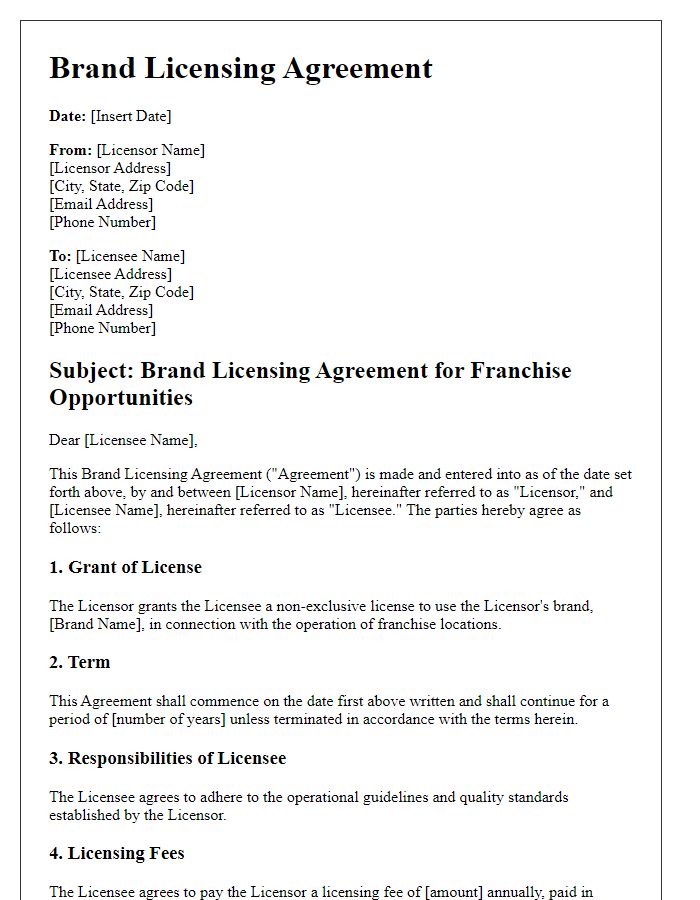Are you ready to unlock new opportunities for your brand? A well-crafted brand licensing agreement can be the key to expanding your reach and enhancing your market presence. In this article, we'll guide you through the essential components of a brand licensing agreement, ensuring that both parties are protected and benefitting from the collaboration. So, let's dive in and discover how to create a winning partnership!

Parties Involved
In a brand licensing agreement, key participants include the Licensor, which is the entity that owns the brand and grants permission to use it, and the Licensee, the party receiving the rights to utilize the brand in specified markets or products. Effective dates should be outlined, such as the start date of the agreement (e.g., January 1, 2024) and the intended duration (e.g., five years with renewal options). Geographic territories covered may include specific regions like North America, Europe, or Asia, indicating the scope of market penetration. Other critical details involve the royalty structure, detailing payment percentages based on sales (often ranging from 5% to 15%) and the reporting frequencies for sales figures (monthly or quarterly). Also included are any performance benchmarks, such as minimum sales thresholds that must be met within the initial year to maintain rights, as well as provisions for termination if obligations are not fulfilled.
Scope of License
The scope of a brand licensing agreement defines the extent of rights granted to the licensee for the use of a trademark or brand name, ensuring clarity and legal compliance. This may include specific permissions to manufacture goods, provide services, or promote products under the licensed brand, such as apparel, cosmetics, or food items. The agreement will typically specify the geographic regions permitted for brand use, ensuring that both parties understand the markets involved, which can range from local (specific cities or states) to global (multiple countries across continents). Additionally, particular product categories can be outlined, ensuring the licensee focuses on approved goods, like athletic wear or beauty products. Restrictions may also be imposed on quality control measures, ensuring brand integrity is maintained. The duration of the license, typically established in years, along with renewability options, can be articulated to provide a timeline for the usage rights granted under the agreement.
Payment and Royalties
Payment structures in brand licensing agreements dictate financial arrangements between licensors and licensees. Royalties typically range from 5% to 15% of gross sales, depending on the brand's market position and product type. Initial licensing fees may also be specified, often exceeding $10,000 for established brands. Payment schedules might include quarterly or biannual remittances, with detailed sales reports required to ensure transparency in earnings. Additional clauses may cover late payment penalties, early termination scenarios, or minimum sales guarantees, ensuring the licensor's brand reputation is maintained while incentivizing the licensee's sales efforts.
Intellectual Property Rights
Brand licensing agreements involve granting permission to use certain trademarks or patented intellectual property, facilitating the creation of revenue streams while protecting brand integrity. This legal document typically outlines specific terms, such as the duration of the license, geographic scope (for example, North America, Europe), and financial arrangements, including royalties (often a percentage of sales, typically ranging from 5% to 15%). Licensees must adhere to quality control standards to prevent dilution of the brand, especially in industries like fashion (where brand image is crucial) or technology (where innovation and patents play a significant role). Furthermore, both parties must agree on dispute resolution mechanisms to address any infringements or breaches, often involving mediation or arbitration systems.
Termination Conditions
Termination conditions in a brand licensing agreement can stipulate specific circumstances under which either party can terminate the agreement. Examples include: failure to meet royalty payment deadlines, consistent failure to adhere to brand guidelines, significant changes in business structure or ownership without prior consent, or any illegal activities associated with the licensed brand. Other conditions may include persistent underperformance in sales metrics (e.g., less than 50% of projected sales over two consecutive quarters), or violation of confidentiality agreements regarding proprietary information. In addition, a party may initiate termination if the other party becomes insolvent or files for bankruptcy under applicable laws, thereby allowing for legal recourse in protecting brand integrity and financial interests.
Letter Template For Brand Licensing Agreement Samples
Letter template of brand licensing agreement for merchandise manufacturing

Letter template of brand licensing agreement for promotional partnerships

Letter template of brand licensing agreement for co-branding initiatives

Letter template of brand licensing agreement for franchise opportunities










Comments